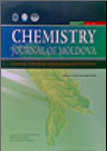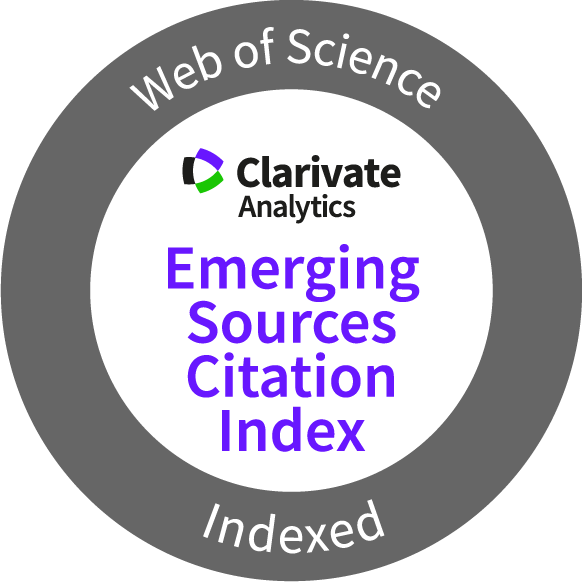Chemistry Journal of Moldova
Ecological chemistry
Author(s):
Field: Ecological chemistry
Type: Invited paper
Issue: 2021 Volume 16, no.2
Pages: 9-27
Sergey Mikhalovsky, Oleksandr Voytko, Violetta Demchenko, Pavlo Demchenko
Field: Ecological chemistry
Type: Invited paper
Issue: 2021 Volume 16, no.2
Pages: 9-27
Full Text (PDF): Download
Abstract (PDF)
Graphical Abstract: Enterosorption is a cost-effective and efficient approach to reducing the impact of chronic exposure to heavy metals and radionuclides. As an auxiliary method to medical treatment, it can protect population chronically exposed to the intake of heavy metals or radioactivity due to industrial activities or in the aftermath of technogenic or natural accidents. This paper assesses the current state of the art in the treatment of acute and chronic heavy metal poisoning.
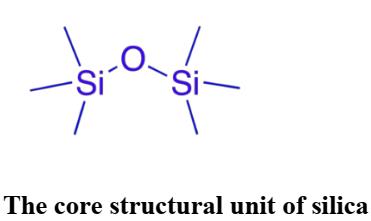
Graphical Abstract: Enterosorption is a cost-effective and efficient approach to reducing the impact of chronic exposure to heavy metals and radionuclides. As an auxiliary method to medical treatment, it can protect population chronically exposed to the intake of heavy metals or radioactivity due to industrial activities or in the aftermath of technogenic or natural accidents. This paper assesses the current state of the art in the treatment of acute and chronic heavy metal poisoning.
Downloads: 93
Author(s):
Field: Ecological chemistry
Type: Research paper
Issue: 2021 Volume 16, no.1
Pages: 68-78
Mariia Galaburda, Viktor Bogatyrov, Dariusz Sternik, Olena Oranska, Mykola Borysenko, Ivan Škorvánek, Ewa Skware, Anna Deryło-Marczewska, Volodymyr Gun’ko
Field: Ecological chemistry
Type: Research paper
Issue: 2021 Volume 16, no.1
Pages: 68-78
Full Text (PDF): Download
Graphical Abstract: The conversion of metal-modified (Fe, Co) sawdust into magneto-sensitive porous composites using thermal carbonization process in an inert atmosphere was successfully achieved. The as-prepared samples were characterized using nitrogen adsorption, X-ray diffraction, scanning electron microscopy and thermal analysis methods. The obtained results show that the structural and morphological characteristics of the obtained composites depend strongly on the metal precursor’s types. All samples exhibited a good magnetic property and can be easily separated from liquids by an external magnet.
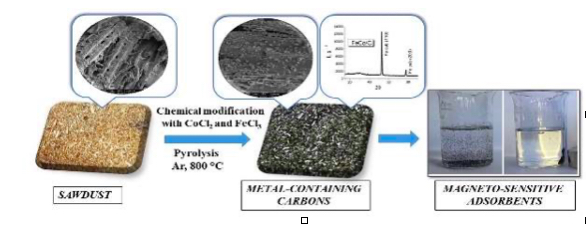
Downloads: 108
Author(s):
Field: Ecological chemistry
Type: Research paper
Issue: 2021 Volume 16, no.1
Pages: 60-67
Gunel Mamedova, Gunel Nasirli
Field: Ecological chemistry
Type: Research paper
Issue: 2021 Volume 16, no.1
Pages: 60-67
Full Text (PDF): Download
Abstract (PDF)
Graphical Abstract: This study presents an investigation of the use of the natural mineral of Nakhchivan Autonomous Republic to produce analcime zeolite of potential practical importance. The influence of temperature and crystallization time, the concentration of alkaline solution and mineralizer on the process of synthesis of analcime has been evaluated. The optimal conditions established for the synthesis of pure analcime with a 100% degree of crystallinity are as follows: temperature of 180°C, alkaline and mineralizer solution of 10-15% KOH and 5-10% KCl and processing time of 50 hours. It has been shown that the presence of the KCl mineralizer promotes the production of pure analcime with a 100% crystallinity, and the natural mineral of Nakhchivan represents a good source for the synthesis process.
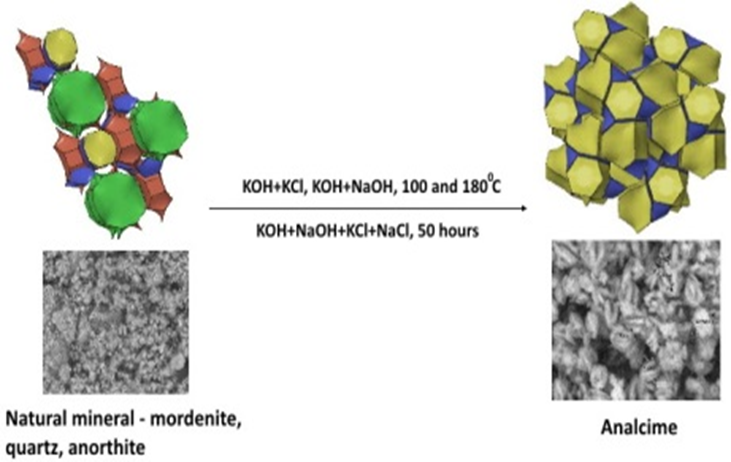
Graphical Abstract: This study presents an investigation of the use of the natural mineral of Nakhchivan Autonomous Republic to produce analcime zeolite of potential practical importance. The influence of temperature and crystallization time, the concentration of alkaline solution and mineralizer on the process of synthesis of analcime has been evaluated. The optimal conditions established for the synthesis of pure analcime with a 100% degree of crystallinity are as follows: temperature of 180°C, alkaline and mineralizer solution of 10-15% KOH and 5-10% KCl and processing time of 50 hours. It has been shown that the presence of the KCl mineralizer promotes the production of pure analcime with a 100% crystallinity, and the natural mineral of Nakhchivan represents a good source for the synthesis process.
Downloads: 454
Author(s):
Field: Ecological chemistry
Type: Research paper
Issue: 2021 Volume 16, no.1
Pages: 46-59
Angela Lis, Viorica Gladchi, Gheorghe Duca, Sergey Travin
Field: Ecological chemistry
Type: Research paper
Issue: 2021 Volume 16, no.1
Pages: 46-59
Full Text (PDF): Download
Abstract (PDF)
Graphical Abstract: The photochemical transformations of thioglycolic acid using model systems was studied by varying the irradiation sources and the kinetic parameters were determined. It was found that thioglycolic acid undergoes destruction on induced photolysis in the presence of humic substances, and its half-life can be estimated as 10-14 days, depending on weather conditions (cloudiness, time of day, season etc.). Results obtained in the course of this study on model systems were transferred to natural waters, and it was concluded that thioglycolic acid has a positive influence on the chemical self-purification processes of water, in the natural aquatic environment. This is manifested by increasing the self-purification capacity of water, due to the generation of active oxygen species, which lead to the degradation not only of this thiol, but of other pollutants present in aquatic environment, as well. At the same time, the products of the transformations are harmless to the aquatic environment and hydrobionts.
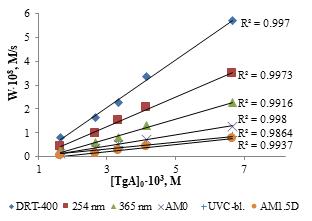
Graphical Abstract: The photochemical transformations of thioglycolic acid using model systems was studied by varying the irradiation sources and the kinetic parameters were determined. It was found that thioglycolic acid undergoes destruction on induced photolysis in the presence of humic substances, and its half-life can be estimated as 10-14 days, depending on weather conditions (cloudiness, time of day, season etc.). Results obtained in the course of this study on model systems were transferred to natural waters, and it was concluded that thioglycolic acid has a positive influence on the chemical self-purification processes of water, in the natural aquatic environment. This is manifested by increasing the self-purification capacity of water, due to the generation of active oxygen species, which lead to the degradation not only of this thiol, but of other pollutants present in aquatic environment, as well. At the same time, the products of the transformations are harmless to the aquatic environment and hydrobionts.
Downloads: 134
Author(s):
Field: Ecological chemistry
Type: Research paper
Issue: 2020 Volume 15, no.2
Pages: 38-44
Vitālijs Lazarenko, Zenta Balcerbule, Vita Rudoviča, Arturs Vīksna
Field: Ecological chemistry
Type: Research paper
Issue: 2020 Volume 15, no.2
Pages: 38-44
Full Text (PDF): Download
Abstract (PDF)
Graphical Abstract: The aim of this research work was to evaluate the pollution level of phosphorus, sulphur and nitrogen in the former manufacturing areas (the former Kuprava drainage pipe
 factory and landfill site) and compare it with the Sita forest area levels using lichens as bioindicators. Additionally, the correlation between the content of these elements in lichens and soil was examined. The research results show that in the former drainage pipe factory area and landfill site, the levels of phosphorus, sulphur and nitrogen content were elevated in comparison with Sita forest. In the case of phosphorus and nitrogen contents, a positive correlation was observed between soil and lichen samples.
factory and landfill site) and compare it with the Sita forest area levels using lichens as bioindicators. Additionally, the correlation between the content of these elements in lichens and soil was examined. The research results show that in the former drainage pipe factory area and landfill site, the levels of phosphorus, sulphur and nitrogen content were elevated in comparison with Sita forest. In the case of phosphorus and nitrogen contents, a positive correlation was observed between soil and lichen samples. Downloads: 119
Author(s):
Field: Ecological chemistry
Type: Research paper
Issue: 2020 Volume 15, no.2
Pages: 29-37
Stefano Ubaldini, Igor Povar, Tudor Lupascu, Oxana Spinu, Francesca Trapasso, Daniele Passeri, Serena Carloni, Daniela Guglietta
Field: Ecological chemistry
Type: Research paper
Issue: 2020 Volume 15, no.2
Pages: 29-37
Full Text (PDF): Download
Graphical Abstract: The application of a new hydrometallurgical process for gold extraction by thiosulphate leaching from Romanian mining wastes, coming from Balan and Deva deposits, was studied. There was obtained 85% of Au extraction after leaching; moreover, an integrated flow-sheet, including recycling of process solution and carbon, was outlined, based on results obtained at a laboratory scale, using a schematic chemical circuit of treatment. Global recovery of the process (leaching-adsorption-desorption-electrodeposition) of about 75-80% of Au was achieved. The developed integrated flow-sheet, allows to recycle the reagents during the process, with a loss of only 5-10%, in particular thiosulphate and alcohol, for each complete circuit of treatment.
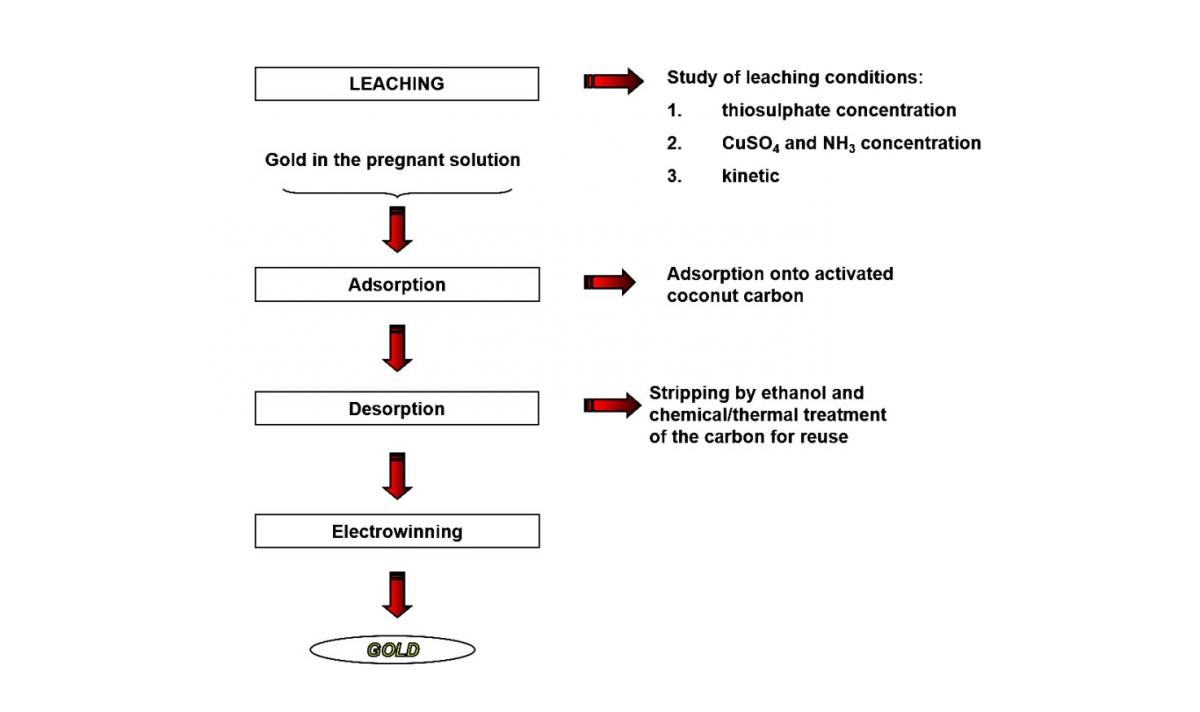

Downloads: 98
Author(s):
Field: Ecological chemistry
Type: Research paper
Issue: 2020 Volume 15, no.1
Pages: 41-50
Elena Culighin
Field: Ecological chemistry
Type: Research paper
Issue: 2020 Volume 15, no.1
Pages: 41-50
Full Text (PDF): Download
Abstract (PDF)
Graphical Abstract: The level, composition, and distribution of hexachlorocyclohexane (HCH) and dichlorodiphenyltrichloroethane (DDT) residues were determined by GC-ECD technique in soil samples from the Soroca district, Republic of Moldova. The concentrations of DDTs and HCHs were up to 1100 and 640 mg/kg, respectively. The high concentration and the degradation rates of the pesticides in soil suggest that the contaminated sites are acting as continuous sources of pollution for the environment. Thus, remediation measures are required to reduce the level of the contaminants in soil.
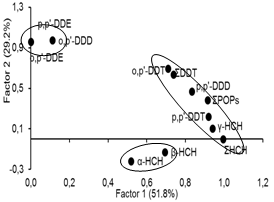
Graphical Abstract: The level, composition, and distribution of hexachlorocyclohexane (HCH) and dichlorodiphenyltrichloroethane (DDT) residues were determined by GC-ECD technique in soil samples from the Soroca district, Republic of Moldova. The concentrations of DDTs and HCHs were up to 1100 and 640 mg/kg, respectively. The high concentration and the degradation rates of the pesticides in soil suggest that the contaminated sites are acting as continuous sources of pollution for the environment. Thus, remediation measures are required to reduce the level of the contaminants in soil.

Downloads: 462
Author(s):
Field: Ecological chemistry
Type: Research paper
Issue: 2020 Volume 15, no.1
Pages: 31-40
Gunel Mamedova
Field: Ecological chemistry
Type: Research paper
Issue: 2020 Volume 15, no.1
Pages: 31-40
Full Text (PDF): Download
Abstract (PDF)
Graphical Abstract: Gismondine, laumontite and levyne type zeolites have been synthesized based on the natural minerals of Nakhchivan and the optimal crystallization conditions have been established. The initial components and the reaction products have been examined by X-ray diffraction, thermogravimetric and elemental analysis. It was found that changes in the temperature, alkalinity, ratio of starting components and time of processing of the reaction have different effects on the rate of formation of products, on their degree of crystallinity and on the phase purity of the obtained zeolite.
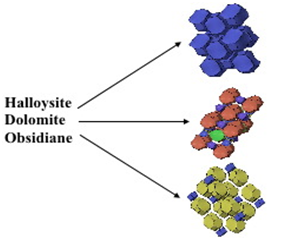
Graphical Abstract: Gismondine, laumontite and levyne type zeolites have been synthesized based on the natural minerals of Nakhchivan and the optimal crystallization conditions have been established. The initial components and the reaction products have been examined by X-ray diffraction, thermogravimetric and elemental analysis. It was found that changes in the temperature, alkalinity, ratio of starting components and time of processing of the reaction have different effects on the rate of formation of products, on their degree of crystallinity and on the phase purity of the obtained zeolite.

Downloads: 833
Author(s):
Field: Ecological chemistry
Type: Research paper
Issue: 2020 Volume 15, no.1
Pages: 21-30
Daniela Guglietta, Girolamo Belardi, Giovanna Cappai, Barbara Casentini, Alicia Godeas, Stefano Milia, Daniele Passeri, Rosamaria Salvatori, Adalgisa Scotti, Vanesa Silvani, Emanuela Tempesta, Stefano Ubaldini, Francesca Trapasso
Field: Ecological chemistry
Type: Research paper
Issue: 2020 Volume 15, no.1
Pages: 21-30
Full Text (PDF): Download
Graphical Abstract: The aim of this paper is to evaluate an integrated multidisciplinary strategy for the characterization of mining waste, their possible recycling and reuse. The use of Fe-Mn rich wastes in arsenic removal and phosphorus recovery from water and the phytoextraction potential of metals and their possible recovery from biomass are evaluated.
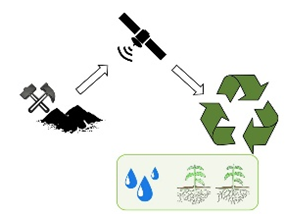

Downloads: 153
Author(s):
Field: Ecological chemistry
Type: Research paper
Issue: 2019 Volume 14, no.2
Pages: 62-71
Raisa Sircu, Gheorghii Turcanu, Nicolae Opopol, Iurie Pinzaru, Tatiana Manceva, Raisa Scurtu
Field: Ecological chemistry
Type: Research paper
Issue: 2019 Volume 14, no.2
Pages: 62-71
Full Text (PDF): Download
Abstract (PDF)
Graphical Abstract: A total of 5206 samples from twenty-one different vegetables and fruits were collected. Residues of pesticides in concentrations exceeding the maximum residue levels were found in 22.9% of analysed samples. Thirteen insecticides, four fungicides, two acaricides and one herbicide were detected in the analysed samples. The highest value of hazard index was calculated for diazinon – 0.15. The obtained results show that the long-term consumption of vegetables and fruits could pose a health risk for the population of the Republic of Moldova.
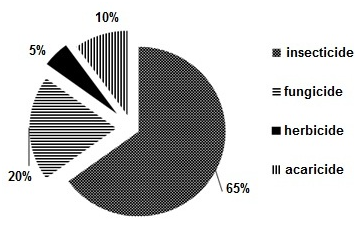
Graphical Abstract: A total of 5206 samples from twenty-one different vegetables and fruits were collected. Residues of pesticides in concentrations exceeding the maximum residue levels were found in 22.9% of analysed samples. Thirteen insecticides, four fungicides, two acaricides and one herbicide were detected in the analysed samples. The highest value of hazard index was calculated for diazinon – 0.15. The obtained results show that the long-term consumption of vegetables and fruits could pose a health risk for the population of the Republic of Moldova.

Downloads: 142
